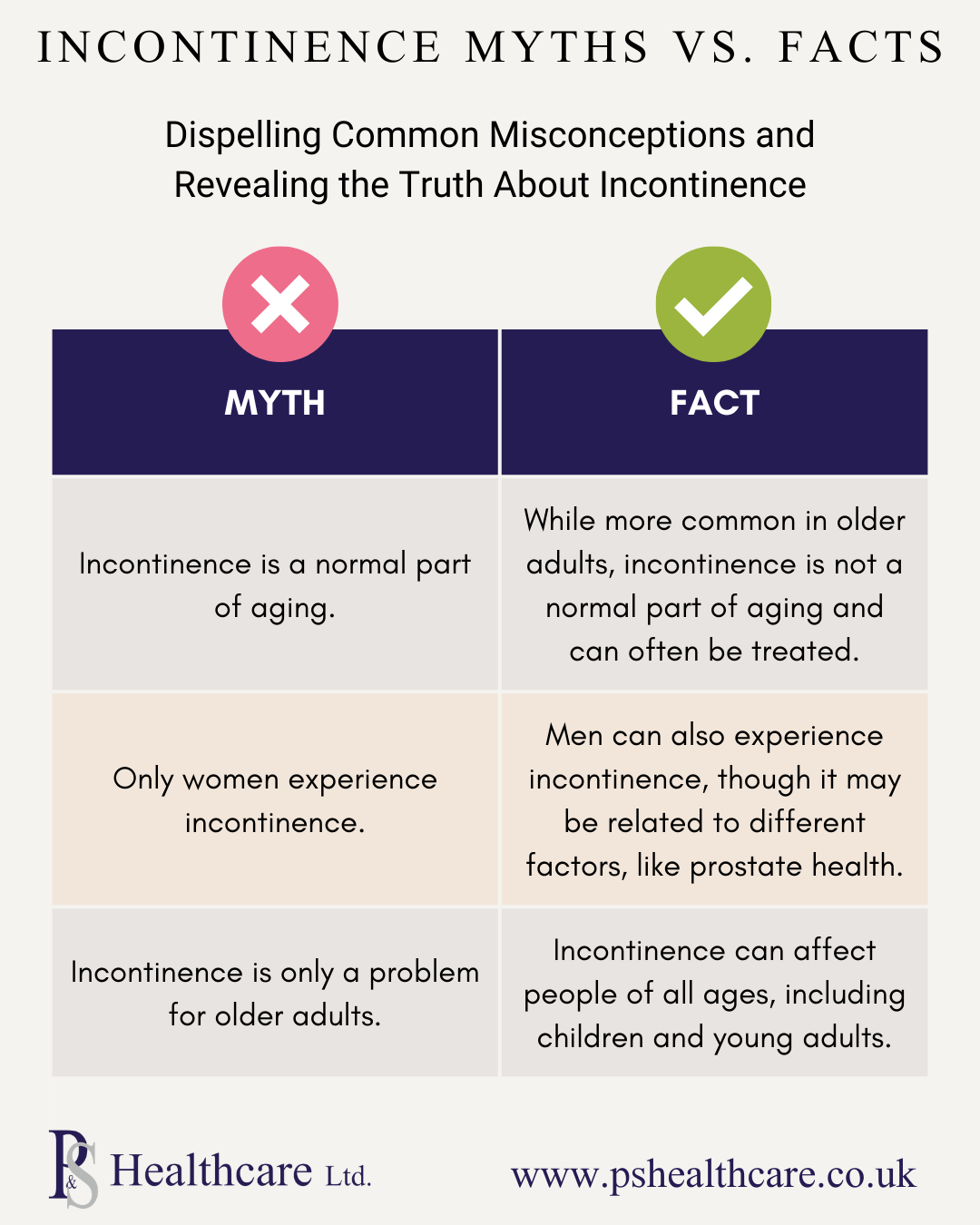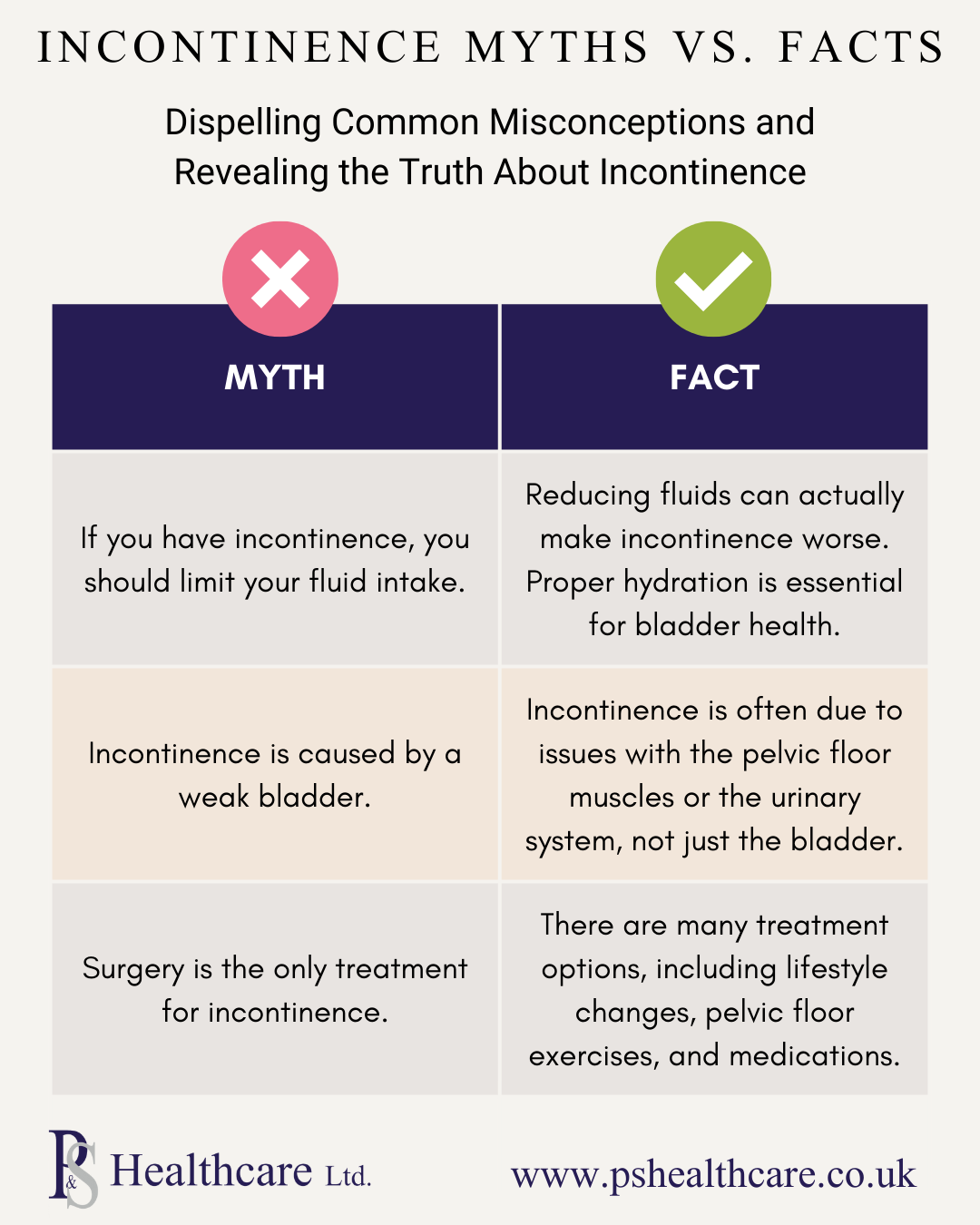Incontinence Myths vs Facts - Dispelling Common Misconceptions

Incontinence is a condition that affects millions of people around the world, but despite its prevalence, there are many myths and misconceptions surrounding it. These misunderstandings can lead to unnecessary embarrassment, improper care, and even the avoidance of seeking treatment. At P&S Healthcare, we believe in providing clear, factual information to help those affected by incontinence better understand their condition and take control of their health. In this article, we’ll separate the myths from the facts and shed light on the truth about incontinence.
Myth: Incontinence is a normal part of aging.
Fact: While incontinence is more common among older adults, it is not an inevitable part of the aging process. Many older adults live their lives without experiencing incontinence, and for those who do, there are often underlying causes that can be treated. Whether the issue is related to pelvic floor dysfunction, medication, or other health conditions, it’s important to understand that incontinence is treatable at any age.
Myth: Only women experience incontinence.
Fact: Incontinence is not just a women’s issue. While women are more likely to experience certain types of incontinence, such as stress incontinence after childbirth, men can also be affected. In men, incontinence is often linked to prostate health, but other factors can contribute as well. It's essential to recognise that incontinence can impact both men and women and seek appropriate treatment accordingly.
Myth: Incontinence is only a problem for older adults.
Fact: Incontinence is not exclusive to older adults. It can affect people of all ages, including children, teenagers, and young adults. Bedwetting in children (nocturnal enuresis), stress incontinence in young athletes, and postpartum incontinence in new mothers are just a few examples. Addressing incontinence early with proper care and treatment is crucial, regardless of age.
Myth: If you have incontinence, you should limit your fluid intake.
Fact: Reducing your fluid intake can actually worsen incontinence. Staying properly hydrated is essential for bladder health, and dehydration can irritate the bladder, leading to more frequent or urgent trips to the bathroom. It’s important to maintain a healthy balance of fluid intake and avoid excessive consumption of bladder irritants like caffeine and alcohol.
Myth: Incontinence is caused by a weak bladder.
Fact: Incontinence is rarely the result of a “weak bladder.” It is often caused by issues with the pelvic floor muscles or problems within the urinary system. Conditions like weakened pelvic floor muscles, nerve damage, or overactive bladder can lead to incontinence. Strengthening the pelvic floor through exercises or seeking medical treatment for underlying causes can help manage and reduce symptoms.
Myth: Surgery is the only treatment for incontinence.
Fact: Surgery is just one of many treatment options for incontinence, and it is typically considered only after other methods have been explored. Lifestyle changes, such as diet modifications, pelvic floor exercises (like Kegels), medications, and physical therapy can all be effective treatments. Consulting with a healthcare professional will help identify the best treatment plan based on the individual’s specific condition.
Take Control of Your Health with Accurate Information
Incontinence is a common condition, but it is surrounded by myths that can prevent people from seeking the care they need. Understanding the facts is the first step toward managing incontinence effectively. At P&S Healthcare, we are committed to helping individuals take control of their health by providing high-quality incontinence products and trusted information. If you or a loved one are experiencing incontinence, remember that it’s a treatable condition, and with the right approach, you can improve your quality of life.
For more information on managing incontinence or to browse our range of reliable incontinence products, visit our website or speak to a healthcare professional today.
Download our handy infographic below.


More News:
- 10 Tips for Night-Time Incontinence Management in Adults
- 10 Ways to Manage Incontinence While Playing Sports
- 10 Tips for Managing Faecal Incontinence in Adults
- 10 Lifestyle Changes to Manage Urinary Incontinence Symptoms
- 10 Ways to Manage Urinary Incontinence During Pregnancy
- 10 Causes of Urinary Incontinence in Men and How to Treat Them
- 10 Practical Solutions for Coping with Incontinence at Work
- 10 Myths About Menopause and Incontinence You Should Stop Believing
- 10 Foods to Avoid to Prevent Bladder Irritation and Incontinence
- 10 Effective Pelvic Floor Exercises for Urinary Incontinence
- 10 Common Causes of Bedwetting in Children and How to Address Them
- Causes of Faecal Incontinence
- Breaking the Silence: Managing Incontinence with Confidence
- Supporting Loved Ones with Incontinence: A Caregiver's Guide
- Top 10 Tips for Managing Incontinence Comfortably This Christmas
- Pregnancy and Postpartum Incontinence: Prevention and Recovery
- 10 Random Facts About Pee You Probably Didn't Know
- Diet and Bladder Health: Foods That Help and Hurt
- Helping Your Child Manage Incontinence: A Parent's Resource
- The Most Common Bladder Control Problems and How to Manage Them
- 10 Things That Can Make Incontinence Worse
- Incontinence Myths vs Facts - Dispelling Common Misconceptions
- Top 10 tips to help with bladder control during pregnancy
- 10 Effective Ways to Stop Bladder Leaks & Manage Incontinence
- P&S Washable Face Mask with ViralOff
- New Product For Men - The Slip Brief
- New Monthly Protection Briefs For Women
- New Product - The OooPS Pant for Stress Incontinence
- New Adult Inco-elite Range Launched
- EMDA WOMEN OF WORTH AWARD 2009
- New Website Launched
- New Website Under Development

